Writing in The Kathmandu Post about the heinous crime in Rukum, Amish Mulmi, starts his column thus:
“There are some events that shock one to the core and drag us by the collar out of our complacent privileged lives.”
But, as far I have been able to tell, Nepali Media does NOT appear to have been sufficiently shocked and, as far as I am concerned, for good reason too!
In remote Rukum, on May 23, 2020, six friends, all Dalits, were hounded and lynched by a mob of 50-60 villagers. The incident took place while the country had been under lockdown — yes under lockdown — on account of the coronavirus pandemic!
Knowing Nepali media, I suspected that they wouldn’t do justice to the heinous crime — I felt they wouldn’t provide sufficient coverage. About a month after the incident, not having seen much coverage, I shared that in a tweet, rounding it off by saying “demographics of d writers covering d issues hasn’t really changed” insinuating that the demographics of those who make up Nepali media were partly to blame.
Coverage of Rukum incident & articles
— Dorje Gurung, ScD (h.c.) (@Dorje_sDooing) June 18, 2020
about d #CasteSystem have abounded lately.
How many papers in#Nepal, however, have
published stories, experiences,
& perspective of #Dalits BY DALITS?
As far as I can tell, demographics of d writers
covering d issues hasn’t really changed.
Nepali media is highly misogynistic, insensitive, and incredibly biased, among a host of other things. I am sure there are a number of reasons for that. One of the reasons, I suspect, is it being the domain of, by, and for Khas-arya (hill so-called high caste Hindu) men, no different from the other three pillars of democracy — the Legislature, the Executive, and the Judiciary — as well as many other structures in the country.
In this blog, I shall be presenting results of a limited analysis of a number of national, MAINSTREAM dailies and one independent media (The Record) for their coverage of the lynching. The victims’ bodies were dumped — some with their hands tied behind their back — into the nearby river! On the third day, cases were filed against twenty alleged perpetrators, and by June 14 that number had risen to thirty-four!
To make something very important clear at the outset: the analysis is NOT an exhaustive one. But, as limited as it is, the results hint at our media indeed being quite insulated and reluctant to provide the necessary space and voice to Dalits, forget actively seek out their voices, among a host of other things.
Most of the data was inputted — by a volunteer — into an online form created for that purpose. The write-ups were published in 11 papers and covered a period of thirty days — from May 23, the day of the incident, to June 22. The papers have some of the largest and widest circulations. I should also include a disclaimer here though. The analysis was conducted by just two of us and, therefore, it may have shortcomings. If so, the errors mine and mine alone.
A total of 71 articles and/or Op-eds appear to have been published in that period. Here’s their breakdown by publication.
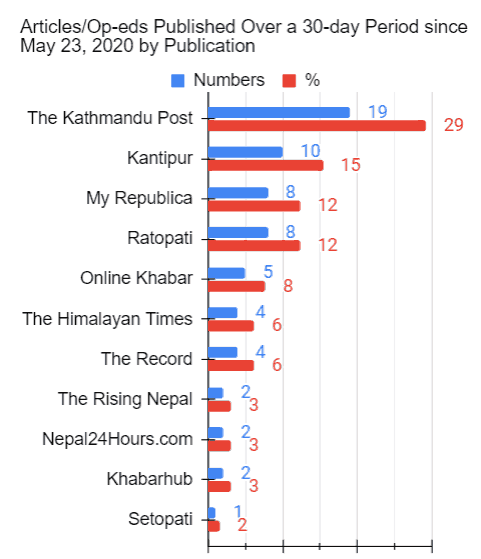
Kantipur (a Nepali daily) and The Kathmandu Post (an English daily), both produced by the same media house, Kantipur Media Group, accounted for 29 of them, 44%. The Rising Nepal, the only public (government owned) paper in the group, published just one article.
What about the gender of the journalists? Not surprisingly, male journalists authored a disproportionately high percent of them.
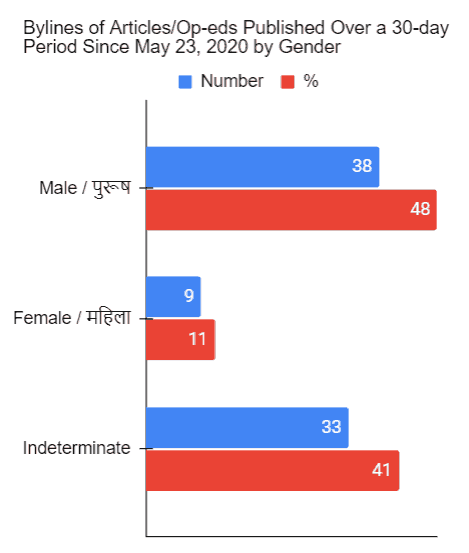
A note about the label “Indeterminate” since it will appear in charts below too. It just means that the byline did NOT carry a name or names.
Furthermore, the 71 write-ups came from just 20 different sources. I say “came from” and “sources” instead of “penned by” and “journalists” because not all of them carried the name or names of the journalists who wrote them. Yes, I am, however, aware media houses or publications have this practice of assigning a journalist or a team to a story. That’s one reason for the lack of variety in the bylines.
Here’s the most important histogram charting the reporting over a 30-day period.
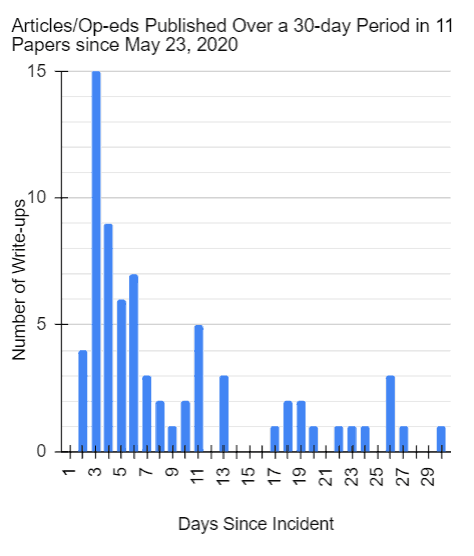
Notice, the apparent interest of the sampled media in the incident dropped off pretty rapidly in spite of its gravity. But, if you know Nepal, that is NOT surprising.
Dalits, the lowest caste, the so-called “untouchables” in Nepali society are the lowest of the low (see below).
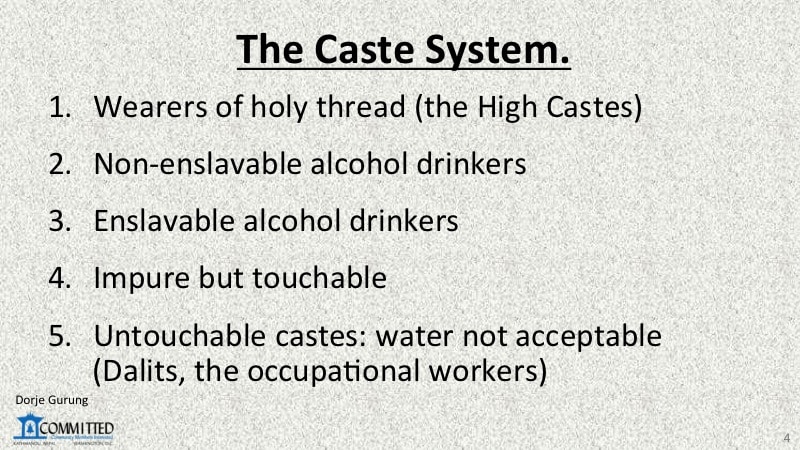
Naturally, their representation in any body of any import, in spite of consisting of about 13% of the population, is either really low or just non-existent. The media is no different.
That, until 1990, the media in Nepal were atrociously biased and didn’t serve the purpose to which they are intended is understandable. Freedom of press and freedom of expression were tightly controlled by the autocratic regimes. Most of the limited media outlets in the country, the rulers controlled, or were in the hands of those connected or privileged and educated enough to afford a printing press — mostly the hill so-called high caste Hindus. Most of them were not going to do anything to anger or antagonize the rulers and they didn’t. Some independence of media came only with the toppling of the autocratic absolute monarch in 1990.
But sadly, even over the three decades since, in the way the media has operated and in the make-up of their personnel, there has NOT been real significant and tangible improvements even with the massive ballooning of media outlets. As far as I can tell, The Record is the only independent media in the entire country, for instance. Not surprisingly, there has been no real or significant progress in what they publish either.
One reason for that is the limited change in who writes. The following for example is a breakdown of the byline of the write-ups by ethnicity/caste.
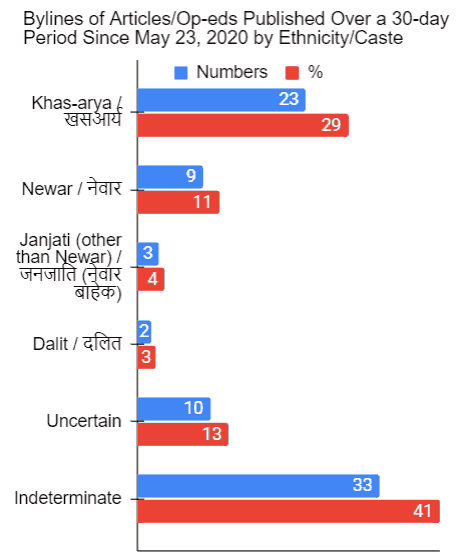
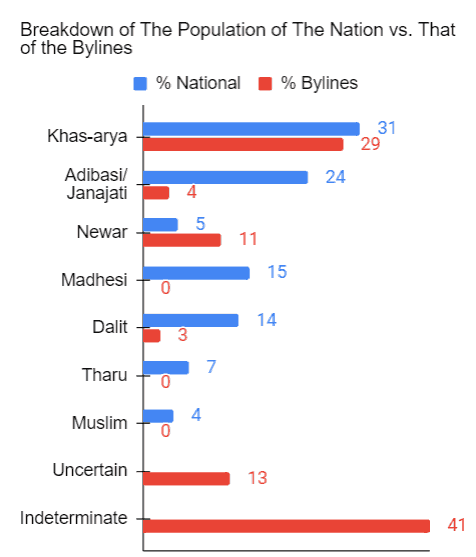
Only 2 (3%) of the bylines were by Dalits, an abysmally small percentage, of course! What’s more, both Dalit journalists’ write-ups were published in Kantipur.
The above reflects or is consistent with the make-up of the various bodies of the Federation of Nepalese Journalists. Here, for instance, is the breakdown of their Central Committee members over the years.
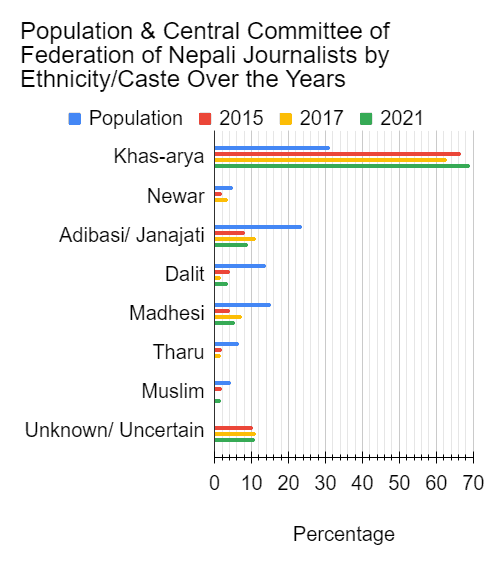
Of course, there’s more where that came from.
That Nepali media failed in their treatment of such a heinous act is just one of the many — but a major — symptom of the degraded psyche of the Nepali society and people by the highly corrupting and monstrous caste system.
The minds of Nepalis have been so corrupted by it that we’ve lost sight of our own — and in many others their — humanity! We are fighting AGAINST humanity when what we should be doing is fighting FOR humanity!
When it comes to the Dalits, throughout history, for generations, they have been dehumanized. Nepali society has been treating them as sub-human or even less than animals for so long by so many, including by the State, that many in the country now fail to see their humanity and have little to no empathy for them, forget acknowledge their plight.
There are Nepalis who won’t accept Dalits being teachers and teaching their children, for example, because then their children will have to greet them with a “Namaskar.” I am sure there are many Hindus in the country who hold the same belief as the Priest in Pyuthan who is convinced that even their God’s discriminate against Dalits — that they’ll be angry if a Dalit entered their temple. Bhim Biswakarma, a Dalit, was beaten up for challenging the ban — one day in October 2021 — on the likes of him worshiping in the local temple during the Hindu festival of Dassain. Since he succumbed to his injuries in the hospital, it might not be a stretch to proclaim that he was essentially murdered for that “transgression.”
The inadequacy of coverage of the grave incident in Rukum and the above examples are but some of the many legacies of a history of dehumanization. Psychology has demonstrated beyond doubt how humans write off people who are dehumanized. The media has been writing them off for a long time and has now contributed to that by not providing adequate and ongoing coverage of the heinous act.
Worse still, such heinous acts of violence are used as a weapon of terror against Dalits to remind them of who they are, to teach them lessons of their “rightful place” (taha in Nepali) in the society, and to hit home the little value placed in the life of a Dalit, among other things.
The villagers lynched Nabaraj and his friends because he dared to fall in love with a female belonging to the so-called high caste and intended to marry her.
In fact, according to Hatemalo Collective, that year — in 2020 — the country recorded a 200% “rise in assault and murder of people from the Dalit community” over 2019! That’s a a 3-fold increase! And remember, from the second half of March 2020, the country had gone into lockdown in response to the coronavirus pandemic. While some of those acts were committed to instill terror, some were likely just Nepalis taking out their frustrations and anger on a vulnerable population, something we tend to do. That is, they were using Dalits as their punching bag, as it were. (Other vulnerable groups that suffer from similar fates are women and children, in homes and schools, among other places.)
To give yet another example, in spite of making up only about 13% of the population, disproportionately high percentage of female victims of rape are Dalits — in both adult (19%) and minor (22%) categories. An article from September 2020 reported that 77 rape cases had been reported to the police in Province 2 over the preceding two months. It notes that “in a majority of the cases, the victim was a Dalit.” Analysis of rapes cases over the period 2018-2020 in Karnali Province, according to an article published in January 2021, discovered 70% of the victims to have been Dalit women and children. Finally, this article in The Record shares a horrendous catalogue of violence against Dalits since the enactment of the Caste Discrimination and Untouchability Act of 2011.
But then again, what can one expect from a society and a people that believes in birth as an end?! What can one expect from Nepalis who believe — and explain — one’s birth caste as a consequence of one’s actions in past lives and therefore deserving of the contexts and circumstances of one’s birth?! That is, what can one expect from a society which believes that the so-called high castes are “deserving” of all the entitlements and privileges while the Dalits all the disadvantages?! Of course, that the disadvantages were actually deliberately instituted by those who were born into privilege are not only NOT taught BUT conveniently denied and swept under the rug as just some inconvenience or uncomfortable truth.
All that and more — such as the level of verbal, emotional, and physical violence in general, the corrupt value system etc. — are but just some symptoms of a deeply flawed, troubled, and corrupt psyche of the society and people. Rehabilitation of this psyche requires a revolution…a revolution of the mind. Otherwise, forget make progress — Nepali society will continue to degrade and degenerate, the way it has for decades now.
What do you think?
Additional Materials
Long before this blog was published, and not long after completion of the analysis, I shared the partial analysis in a twitter thread. The blog however includes more write-ups but excludes People’s Review since it’s not one of the mainstream publications nor is it as widely recognized.
I have written a great deal about the caste system and, if you are interested in the details I have alluded to in this blog, follow the links below.
- In the Land Everyone Takes Pride in as the Birth Place of Buddha, We are Very Short on Compassion reproduces Nepalis’ responses, on twitter, to a tweet by a Dalit woman expressing a desire to live as a human being.
- Buddha Was Born… is about how Nepalis should focus on what he taught in addition to taking pride in his birth in the country.
- The Story of Eklavya and Dronarcharya: More of Caste Supremacy Than Model Discipleship is about how the mythology exemplifies the terror tactics used to suppress Dalits and others to maintain and justify caste supremacy, among other things.
- Birth is a Beginning…Not an End…As the Hindus Would Have You Believe is about the Hindus’ belief that the caste you are born into is a consequence of ones past-life actions (Karma) and therefore deserved.
- Caste System Can Corrupt The Mind, Kill The Spirit, And Strip One of Humanity is about how Nepal is in denial of the caste system and their dehumanization of Dalits.
- Like Gods, Like Humans? Or, Like Humans, Like Gods? Or, Like…F*cked up? is about how some in Nepal justify prohibiting Dalits from practicing their religion by entering temples.
- Social Justice: Caste Away is about how Nepali society viewing and treating Dalits (and others) as inferior because of their low-caste birth and forcing them to live their lives in shame as a “punishment” is wrong and, if anyone should be ashamed, it should be those who interpret their birth caste as such and make them suffer.
- Grade 8 Social Studies Textbook: The Caste System Is a “small” Issue is about how that’s the ONLY entry about the system in the whole textbook.
- Social Justice: Want Compassion? Show Compassion! is about how Dalits were DELIBERATELY prevented from receiving relief materials in some places and, in others, provided left overs following the quakes of 2015.
- Caste Out is a Dalit’s personal story of life-long discrimination and abuse.
- Caste System Fostered and Propped up Groupism in Nepal Corrals People into Small Social Circles Part I is about how Nepalis are still highly tribal.
- So You Think There is No Caste-based Discrimination in Nepal? Think Again! reproduces a twitter thread — started in July 2018 — documenting incidences of discrimination and abuse Dalits suffer from.
